| Beijing Culture
MUSEUMS
Beijing is the capital city of China as well as the cultural and
political center of the country. Used to be the capital of many
dynasties, Beijing has many world-famous museums. For the
information of Beijing museums, you can log on
http://chinamuseums.com/beijing.htm
Starting from March 23, 2008, 33 museums
in Beijing have been open to visitors free of charge. There are some
free ones you might be interested in:
|
Capital Museum
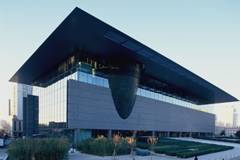 With
its magnificent architecture, abundant exhibitions,
advanced technology and complete functions, the Capital
Museum makes its contribution to the titles such as
¡°famous historical and cultural city¡±, ¡°cultural center¡±
and ¡°international metropolis¡± of Beijing. With
its magnificent architecture, abundant exhibitions,
advanced technology and complete functions, the Capital
Museum makes its contribution to the titles such as
¡°famous historical and cultural city¡±, ¡°cultural center¡±
and ¡°international metropolis¡± of Beijing. |
http://www.capitalmuseum.org.cn/en/index.htm
Open Time: 9:00 to 17:00 Tuesdays through Sundays
(tickets stop at 16:00)
Ticket Prices: Free
Routes:
Subway: Muxidi Station, Line 1
Buses:
¢ÙNo. 1, No. 4, No. 52 and No. 37 to the stop
¡°Gonghuidalou¡± (Labor Union Building)
¢ÚNo. 937, No. 727, No. 717, No. 650, No. 708, No. 26,
No. 319 to the stop Baiyun Rd.
¢ÛSpecial Bus No. 1 to the stop ¡°Muxidi¡±
Number for Telephone Reservation: 010-63370491/
63370492 |
|
Beijing Museum of Natural History
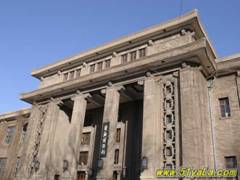 Being
the first large-scale museum of natural history, the
museum today boasts its rich collections, high-level
research and ever-enlarging exhibitions. It has been one
of a few museums of natural history in China. Being
the first large-scale museum of natural history, the
museum today boasts its rich collections, high-level
research and ever-enlarging exhibitions. It has been one
of a few museums of natural history in China. |
http://www.bnhm.cn/web/en/index.htm
Open Time: 8:30-17:00 Tuesdays through Sundays
Group Reserve: more than 20 persons.
Ticket Prices: Free
Address: 126, Tianqiao ST, Beijing,100050,PRC
Routes:
Buses:
No. 2, No. 6, No. 7 and No. 15 No. 17, No. 20, No. 34,
No. 35, No. 36, No. 59, No. 110, No. 707, No. 729, No.
742, No. 743, No. 744, No. 803 to the stop Tianqiao
Number for telephone reservation:
010-67024439,67024435(group);
67024431,67020733(individual) |
|
Museum of Ethnic Costumers of Beijing University of
Clothing and Technology:
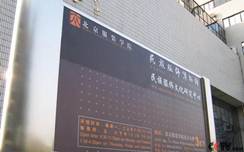 All
that is exhibited here may be treasured as folk art.
These costumes are not just part of our national
culture; they are a pure form of folk art. With their
pleasing forms and intrinsic meaning, these costumes are
China's national treasures. All
that is exhibited here may be treasured as folk art.
These costumes are not just part of our national
culture; they are a pure form of folk art. With their
pleasing forms and intrinsic meaning, these costumes are
China's national treasures. |
http://www.cnnc.org/cnnc/cnen/index.asp
Open Time: 8:30-11:30am on Monday and
Tuesday,13:30-16:30pm on Thursday, Friday and Saturday
Ticket Prices: Free
Address: Beijing Universty of Clothing
Technology, Heping jie beikou, Beijing China
Routes:
Buses:
No.13, No. 62, No. 416, No. 422, No. 713, No. 725, and
No. 730 to the stop Hepingjie Beikou
Tel: 86-10-64288259 64288261 |
|
The Museum of Beijing People¡¯s Art
Theater:
 Capital
Theatre has showed the achievements established by the
theatre's artists generation after generation. The
Capital Theatre is recorded in world¡¯s architecture
history with its simple and unsophisticated, dignified
and grandiose architect style. Capital
Theatre has showed the achievements established by the
theatre's artists generation after generation. The
Capital Theatre is recorded in world¡¯s architecture
history with its simple and unsophisticated, dignified
and grandiose architect style. |
http://www.bjry.com/main.asp
Open Time: According to the drama arrangement
Ticket Prices: Free
Address: 22 Wangfujing Street, Beijing, China
Routes:
Subway: Wangfujing Station, Line 1
Dongsi Station, Line 5
Buses:
No.101, No. 103, No. 104, No. 108, No. 109, No. 111,
No.112, No. 420, No. 803, No. 810, No. 8140,and No. 846
to the stop Meishuguan or stop Dengshilukouxi
Number for telephone reservation: 010-65250996/
65249847 |
HUTONG
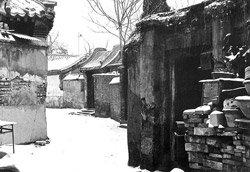 Beijing Hutong Beijing Hutong
The Beijing Hutong has a very special and important position in the
rich history and culture of Beijing.
The Beijing Hutong is one of the "must see" items in Beijing. They
are the wonderful glimpse into the world of yesterday in Beijing.
While visiting the Beijing Hutongs, you can feel the dramatic
changes of Beijing and you can experience the life style and
traditional culture of Beijing.
 What is Hutong What is Hutong
The word "hutong" originates from the word "hottog" which means
"well" in Mongolian. Villagers dig out a well and inhabited there.
Hutong means a lane or alley, in fact the passage formed by lines of
siheyuan (a compound with houses around a courtyard) where old
Beijing residents live. Take care not to lose in it! It was recorded
that in the Yuan a 36-meter-wide road was called a standard street,
a 18-meter-wide one was a small street and a 9-meter-wide lane was
named a hutong. In fact, Beijing hutongs are inequable ranging from
40 centimeter to 10 meter in wide. The longest has more than 20
turns. Either in east-west or north-south, Beijing hutongs vary as
slant, half or ¡°blind hutongs", cul-de-sacs. The gray-tiled houses
and deep alleys crossing with each other in identical appearance
like a maze, you will find it much fun to walk through but be
careful not to lose yourself.
 Hutong Culture Hutong Culture
The name of a hutong implicates its origin, location or history. It
is in the gray-tiled deep lanes that families play, travel, buy
goods, gossip and connect. In Beijingers' eyes, hutongs means a
period of history, a cordial lifestyle and even an "encyclopedia of
Beijing".
When a certain name was given and
prevailed among people, it exactly became the necessary symbol for
intercourses and communication. From the names of hutongs one can
discover how Beijingers, in the course of centuries, advanced from
vulgarity to refinement. In numerous hutongs are scattered the
residences of famous personages, and these places are repositories.
Laoshe, a well - known playwright is just one of them. Laoshe was
born in a small lane, in the west part of the city. The memory of
his childhood was so dear and impressive that after he'd been away
from Beijing for more than 20 years, he still clearly remembered his
birthplace, and he made it the backdrop of his novel "the Four
Generations under One Roof". Many famous operas and dramas are based
on the themes of the ¡°hutong life". A visit to hutongs plus a drama
by the Beijing People's Art Theatre, such as ¡°Teahouse" or ¡°Small
Hutong" in the evening will help you appreciate the fundamental part
of life in Beijing. When urban construction threatens the existence
of these hutongs, some Beijingers become worried.
Courtyard Culture
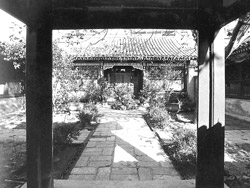 The Dwelling
compounds or quadrangles (Siheyuan) - the enclosed, one-story
courtyard houses that make up old Beijing, feature a typical Chinese
folk residential architecture. The Dwelling
compounds or quadrangles (Siheyuan) - the enclosed, one-story
courtyard houses that make up old Beijing, feature a typical Chinese
folk residential architecture.
A standard Siheyuan usually falls into a
rectangular compound with one-story houses squarely facing the
cardinal points and a courtyard in middle.
Some large compounds have two or more
courtyards, inhabited by an extended family with several
generations. "Four Generations under One Roof", a novel by the
contemporary writer Lao She, depicts Beijingers in the 1930s and
1940s living in Siheyuan.
Beijing still has about 400,000
residential quadrangles now, mainly distributed over the East, West,
Xuanwu and Chongwen districts. The municipal government has
earmarked a number of dwelling compounds for protection.
BEIJING OPERA
Beijing Opera
Beijing Opera is the quintessence of China. The largest Chinese
opera form, it is extolled as 'Oriental Opera'. Having a history of
160 years, it has created many 'firsts' in Chinese dramas: the
abundance of repertoires, the number of artists, opera troupes and
spectators.
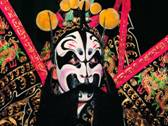 Beijing Opera is
developed from absorbing many other dramatic forms, mostly from the
local drama 'Huiban' which was popular in South China during the
18th century. It is a scenic art integrating music, performance,
literature, aria, and face-painting. Certain rules are set up and
regulations are standardized during many artists' long practice on
stage. Different from regional plays, it is stricter on the variety
of the workmanship. The combination of virtual and reality - a
special technique of expression, keeps it largely free from the
restriction of time and space on stage performance. Beijing Opera
has had many interesting names since it came into being, such as
Jinghuang, Daxi, Pingju, Jingxi. Beijing Opera is
developed from absorbing many other dramatic forms, mostly from the
local drama 'Huiban' which was popular in South China during the
18th century. It is a scenic art integrating music, performance,
literature, aria, and face-painting. Certain rules are set up and
regulations are standardized during many artists' long practice on
stage. Different from regional plays, it is stricter on the variety
of the workmanship. The combination of virtual and reality - a
special technique of expression, keeps it largely free from the
restriction of time and space on stage performance. Beijing Opera
has had many interesting names since it came into being, such as
Jinghuang, Daxi, Pingju, Jingxi.
Four Means of Artistic Presentation
Beijing Opera presents dramatic plays and figures mainly by infusing
four artistic methods: singing, dialogue, dancing and martial art.
Singing is utilized to intensify the appeal of the art by all kinds
of tones. Dialogue is the complement of singing which is full of
musical and rhythm sensation. Dancing refers to the body movements
requiring high performing skills. Martial art is the combination and
transformation of traditional Chinese combat exercises with dances.
Main Roles in Beijing Opera
Performance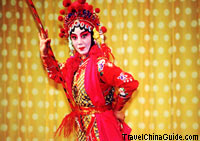
Sheng: It's a common name of male characters and composed of Lao
Sheng and Xiao Sheng. Lao Sheng refers to the middle-aged man with a
beard who acts as the decency figure; for example, Zhugeliang in
'Empty City Scheme'. Xiao Sheng means young man without a beard.
Zhangsheng in 'The Story of the West Room' is a representative of
Xiao Sheng.
Dan: The general name for female
characters in Beijing Opera can be divided into Zhengdan, Huadan,
Laodan, Wudan. Zhengdan is also called 'Qingyi', who mainly plays
the part of the strong-minded middle-aged woman who behaves
elegantly. Huadan refers to little girls who often live in the
bottom of society. Laodan refers to the senior woman and Wudan
indicates the female who is good at fighting.
Jing: Painted face often refers to male
characters with unique appearance or personality, such as Baozheng
and Caocao. Besides, Chou is a comic role or villainous character or
righteous person. The actor's nose is painted by a piece of white
powder, making him or her easily recognizable.
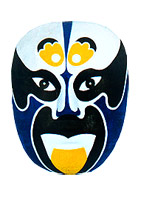 Facial Painting (Lianpu) Facial Painting (Lianpu)
Lianpu is formed through dramatic artists' long-term practice and
their understanding and judgment of the roles in plays. It is the
colorful dressing on actors' faces. By using transformative and
exaggerated figures, professional spectators would easily tell the
characteristic of a role. In this way, it is called 'the picture of
hearts'. There are certain formats of the facial painting in the
aspect of color, type and shape. Usually, eyes, foreheads and cheeks
are painted like wings of butterflies, swallows and bats.
Colors of Lianpu are varied with each representing a characteristic.
For example, red symbolizes loyalty, such as Guanyu, a great general
during Three Kingdoms Period (220-280). Black signifies honesty and
frankness, such as Lord Bao, a righteous official during Northern
Song Dynasty (960-1127), or abruptness and impertinence, such as
Likui, an important figure in the famous Chinese ancient novel 'All
Men Are Brothers'. White stands for cattiness and cunning, with
Caocao as its representative, a famous politician in the late
Eastern Han Dynasty (25-220).
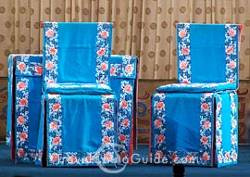 Stage Properties (Qimo) Stage Properties (Qimo)
Qimo is a general designation for all kinds of stage properties and
simple settings used in Beijing Opera performances. It comes from
the real life experience. For example, an actor can practice the
scene of galloping the horse simply by using a horsewhip without
riding a real horse on stage. A bridge is made up of two chairs
standing on each side of a table. Storms are realized by performers
dancing with umbrellas.
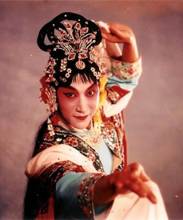 Four Famous Artists Four Famous Artists
There are many famous masters who are good at performing Beijing
Opera. Among them, the Four Famous Dans - Mei Lanfang, Cheng Yanqiu,
Shang Xiaoyun and Xun Huisheng - are most well-known at home and
abroad. They are experts in performing the role of Dan and each has
his own artistic feature. Their wonderful performances are still
appreciated by many audiences. For example, 'Farewell My Concubine'
by Mei Lanfang, 'Injustice to Dou'e' by Cheng Yanqiu, 'Lady Zhaojun
Going beyond the Great Wall' by Shang Xiaoyun and 'Matchmaker' by
Xun Huisheng.
Beijing Opera contains the soul of
Chinese national culture. Its unique charm inspires ethos of Chinese
people. There is no doubt that it is really the treasure of Chinese
culture. If you want to taste the real Beijing Opera, Liyuan Theatre
in Beijing will be a good choice for you. |

 With
its magnificent architecture, abundant exhibitions,
advanced technology and complete functions, the Capital
Museum makes its contribution to the titles such as
¡°famous historical and cultural city¡±, ¡°cultural center¡±
and ¡°international metropolis¡± of Beijing.
With
its magnificent architecture, abundant exhibitions,
advanced technology and complete functions, the Capital
Museum makes its contribution to the titles such as
¡°famous historical and cultural city¡±, ¡°cultural center¡±
and ¡°international metropolis¡± of Beijing.  Being
the first large-scale museum of natural history, the
museum today boasts its rich collections, high-level
research and ever-enlarging exhibitions. It has been one
of a few museums of natural history in China.
Being
the first large-scale museum of natural history, the
museum today boasts its rich collections, high-level
research and ever-enlarging exhibitions. It has been one
of a few museums of natural history in China. All
that is exhibited here may be treasured as folk art.
These costumes are not just part of our national
culture; they are a pure form of folk art. With their
pleasing forms and intrinsic meaning, these costumes are
China's national treasures.
All
that is exhibited here may be treasured as folk art.
These costumes are not just part of our national
culture; they are a pure form of folk art. With their
pleasing forms and intrinsic meaning, these costumes are
China's national treasures. Capital
Theatre has showed the achievements established by the
theatre's artists generation after generation. The
Capital Theatre is recorded in world¡¯s architecture
history with its simple and unsophisticated, dignified
and grandiose architect style.
Capital
Theatre has showed the achievements established by the
theatre's artists generation after generation. The
Capital Theatre is recorded in world¡¯s architecture
history with its simple and unsophisticated, dignified
and grandiose architect style. Beijing Hutong
Beijing Hutong What is Hutong
What is Hutong Hutong Culture
Hutong Culture The Dwelling
compounds or quadrangles (Siheyuan) - the enclosed, one-story
courtyard houses that make up old Beijing, feature a typical Chinese
folk residential architecture.
The Dwelling
compounds or quadrangles (Siheyuan) - the enclosed, one-story
courtyard houses that make up old Beijing, feature a typical Chinese
folk residential architecture.  Beijing Opera is
developed from absorbing many other dramatic forms, mostly from the
local drama 'Huiban' which was popular in South China during the
18th century. It is a scenic art integrating music, performance,
literature, aria, and face-painting. Certain rules are set up and
regulations are standardized during many artists' long practice on
stage. Different from regional plays, it is stricter on the variety
of the workmanship. The combination of virtual and reality - a
special technique of expression, keeps it largely free from the
restriction of time and space on stage performance. Beijing Opera
has had many interesting names since it came into being, such as
Jinghuang, Daxi, Pingju, Jingxi.
Beijing Opera is
developed from absorbing many other dramatic forms, mostly from the
local drama 'Huiban' which was popular in South China during the
18th century. It is a scenic art integrating music, performance,
literature, aria, and face-painting. Certain rules are set up and
regulations are standardized during many artists' long practice on
stage. Different from regional plays, it is stricter on the variety
of the workmanship. The combination of virtual and reality - a
special technique of expression, keeps it largely free from the
restriction of time and space on stage performance. Beijing Opera
has had many interesting names since it came into being, such as
Jinghuang, Daxi, Pingju, Jingxi.
 Facial Painting (Lianpu)
Facial Painting (Lianpu)
 Stage Properties (Qimo)
Stage Properties (Qimo) Four Famous Artists
Four Famous Artists